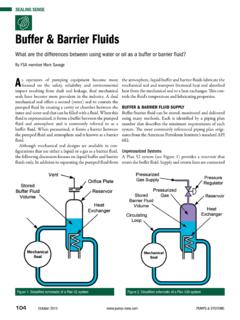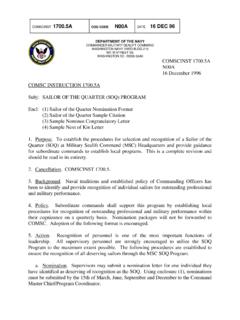Transcription of The BASICS Back in 1904, British scientist John …
1 The BASICSBack in 1904 , British scientist john AmbroseFleming first showed his device to convert analternating current signal into direct current. The"Fleming diode" was based on an effect thatThomas Edison had first discovered in 1880, andhad not put to useful work at the time. This diodeessentially consisted of an incandescent light bulbwith an extra electrode inside. When the bulb'sfilament is heated white-hot,electrons are boiled off itssurface and into the vacuum inside the bulb. If the extra electrode(also called an "plate" or "anode") is made more positive than thehot filament, a direct current flows through the vacuum. And sincethe extra electrode is cold and the filament is hot, this current canonly flow from the filament to the electrode, not the other , AC signals can be converted into DC. Fleming's diode was firstused as a sensitive detector of the weak signals produced by thenew wireless telegraph.
2 Later (and to this day), the diode vacuumtube was used to convert AC into DC in power supplies for electronic other inventors tried to improve the Fleming diode, most without success. Theonly one who succeeded was New York inventor Lee de Forest. In 1907 he patented abulb with the same contents as the Fleming diode, except for an added electrode. This"grid" was a bent wire between the plate and filament. de Forest discovered that if heapplied the signal from the wireless-telegraph antenna to the grid instead of thefilament, he could obtain a much more sensitive detector of the signal. In fact, the gridwas changing ("modulating") the current flowing from the filament to the plate. Thisdevice, the Audion, was the first successful electronic amplifier. It was the genesis oftoday's huge electronics 1907 and the 1960s, a staggering array of different tube familieswas developed, most derived from de Forest's invention.
3 With a very fewexceptions, most of the tube types in use today were developed in the1950s or 1960s. One obvious exception is the 300B triode, which was firstintroduced by Western Electric in 1935. Svetlana's SV300B version, plusmany other brands, continue to be very popular with audiophiles aroundthe world. Various tubes were developed for radio, television, RF power,radar, computers, and specialized applications. The vast majority of thesetubes have been replaced by semiconductors, leaving only a few types inregular manufacture and use. Before we discuss these remainingapplications, let's talk about the structure of A TUBEAll modern vacuum tubes are based on the concept of the Audion--a heated "cathode"boils off electrons into a vacuum; they pass through a grid (or many grids), whichcontrol the electron current; the electrons then strike the anode (plate) and areabsorbed. By designing the cathode, grid(s) and plate properly, the tube will make asmall AC signal voltage into a larger AC voltage, thus amplifying it.
4 (By comparison,today's transistor makes use of electric fields in a crystal which has been speciallyprocessed a much less obvious kind of amplifier, though much more important intoday's world.)Figure 3 (Inside a miniature tube) shows a typical modern vacuum tube. It is a glassbulb with wires passing through its bottom, and connecting to the various electrodesinside. Before the bulb is sealed, a powerful vacuum pump sucks all the air and gasesout. This requires special pumps which can make very "hard" vacuums. To make a goodtube, the pump must make a vacuum with no more than a millionth of the air pressureat sea level (one microTorr, in official technical jargon). The "harder" the vacuum, thebetter the tube will work and the longer it will last. Making an extremely hard vacuum ina tube is a lengthy process, so most modern tubes compromise at a level of vacuumthat is adequate for the tube's , let's talk about the parts of the CathodeToday, nearly all tubes use one of two different kinds of cathode to generate ) The thoriated filament: it is just a tungsten filament, much like that in a light bulb,except that a tiny amount of the rare metal THORIUM was added to the tungsten.
5 Whenthe filament is heated white-hot (about 2400 degrees Celsius), the thorium moves tothe outer surface of it and emits electrons. The filament with thorium is a much bettermaker of electrons than the plain tungsten filament by itself. Nearly all big power tubesused in radio transmitters use thoriated filaments, as do some glass tubes used in hi-fiamps. The thoriated filament can last a VERY long time, and is very resistant to ) The other kind of cathode is the oxide-coated cathode or filament. This can be eitherjust a filament coated with a mixture of barium and strontium oxides and othersubstances, or it can be an "indirectly heated" cathode, which is just a nickel tube with acoating of these same oxides on its outer surface and a heating filament inside. Thecathode (and oxide coating) is heated orange-hot, not as hot as the thoriated filament--about 1000 degrees Celsius. These oxides are even better at making electrons than thethoriated filament.
6 Because the oxide cathode is so efficient, it is used in nearly allsmaller glass tubes. It can be damaged by very high voltages and bombardment bystray oxygen ions in the tube, however, so it is rarely used in really big power ) Lifetime of cathodes: The lifetime of a tube is determined by the lifetime of itscathode emission. And the life of the of a cathode is dependent on the cathodetemperature, the degree of vacuum in the tube, and purity of the materials in thecathode. Tube life is sharply dependent on temperature, which means that it is dependenton filament or heater operating voltage. Operate the heater/filament too hot, andthe tube will give a shortened life. Operate it too cool and life may be shortened(especially in thoriated filaments, which depend on replenishment of thorium bydiffusion from within the filament wire). A few researchers have observed that thelifetime of an oxide-cathode tube can be greatly increased by operating its heaterat 20% below the rated voltage.
7 This USUALLY has very little effect on thecathode's electron emission, and might be worth experimenting with if the userwishes to increase the lifetime of a small-signal tube. (Low heater voltage is NOTrecommended for power tubes, as the tube may not give the rated power output.)Operating the heater at a very low voltage has been observed to linearize sometube types-- we have not been able to verify this, so it may be another worthyexperiment for an OEM or sophisticated experimenter. The average end-user isadvised to use the rated heater or filament voltage experimentation is notrecommended unless the user is an experienced technician. Oxide cathodes tend to give shorter lifetimes than thoriated filaments. Purity ofmaterials is a big issue in making long-lived oxide cathodes--some impurities,such as silicates in the nickel tube, will cause the cathode to lose emissionprematurely and "wear out". Low-cost tubes of inferior quality often wear outfaster than better-quality tubes of the same type, due to impure cathodes.
8 Small-signal tubes almost always use oxide cathodes. Good-quality tubes of thistype, if operated well within their ratings and at the correct heater voltage, canlast 100,000 hours or more. The world record for lifetime of a power tube is held by a large transmittingtetrode with a thoriated filament. It was in service in a Los Angeles radio station'stransmitter for 10 years, for a total of more than 80,000 hours. When finally takenout of service, it was still functioning adequately. (The station saved it as a spare.)By comparison, a typical oxide-cathode glass power tube, such as an EL34, willlast about 1500-2000 hours; and a tube with an oxide-coated filament, such as anSV300B, will last about 4000-10,000 hours. This is dependent on all the factorslisted above, so different customers will observe different Plate (anode)The plate, or anode, is the electrode that theoutput signal appears on. Because the plate hasto accept the electron flow, it can get in power tubes.
9 So it is speciallydesigned to cool itself off, either by radiatingheat through the glass envelope (if it's a glasstube), or by forced-air or liquid cooling (in biggermetal-ceramic tubes). Some tubes use a platemade of graphite, because it tolerates hightemperatures and because it emits very fewsecondary electrons, which can overheat thetube's grid and cause failure. See "H--the getter"below for more about the graphite Control GridIn nearly all glass audio tubes, the control grid is a piece of plated wire, wound aroundtwo soft-metal posts. In small tubes the plating is usually gold, and there are two postsmade of soft copper. Grids in big power tubes have to tolerate a lot of heat, so they areoften made of tungsten or molybdenum wire welded into a basket form. Some largepower tubes use basket-shaped grids made of graphite (see D below).Inside any modern amplifying tube, one of the things to avoid is called secondaryemission.
10 This is caused by electrons striking a smooth metal surface. If manysecondary electrons come out of the grid, it will lose control of the electron stream, sothat the current "runs away", and the tube destroys itself. So, the grid is often platedwith a metal that is less prone to secondary emission, such as gold. Special surfacefinishing is also used to help prevent secondary tube with only one grid is a TRIODE. The most widely used small triode, the 12AX7, isa dual triode which has become the standard small-signal amplifier in guitar small glass triodes used in audio equipment include the 6N1P, 6DJ8/6922, 12AT7,12AU7, 6CG7, 12BH7, 6SN7 and glass power triodes are currently on the market, most ofthem aimed at amateur radio or high-end audio use. Typicalexamples are the Svetlana SV300B, SV811/572 series, and572B. Power triodes come in "low-mu" (low gain) and "high-mu" (high gain) versions. Low-mu triodes like the SV300 Bhave very low distortion and are used in high-end audioamplifiers, while high-mu triodes are used mostly in radiotransmitters and big high-power audio ceramic-metal power triodes are often used in radiotransmitters and to generate radio energy for industrial heatingapplications.





